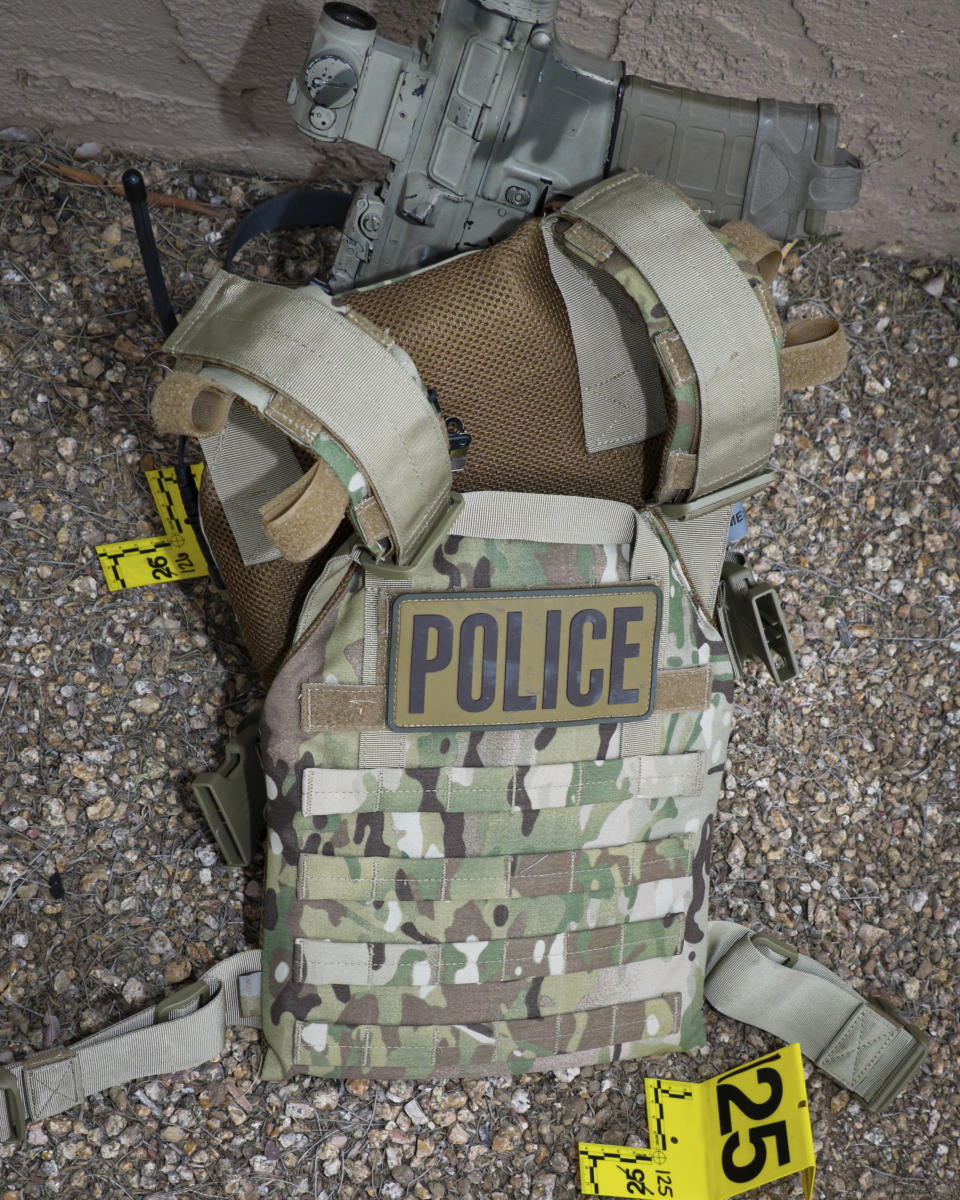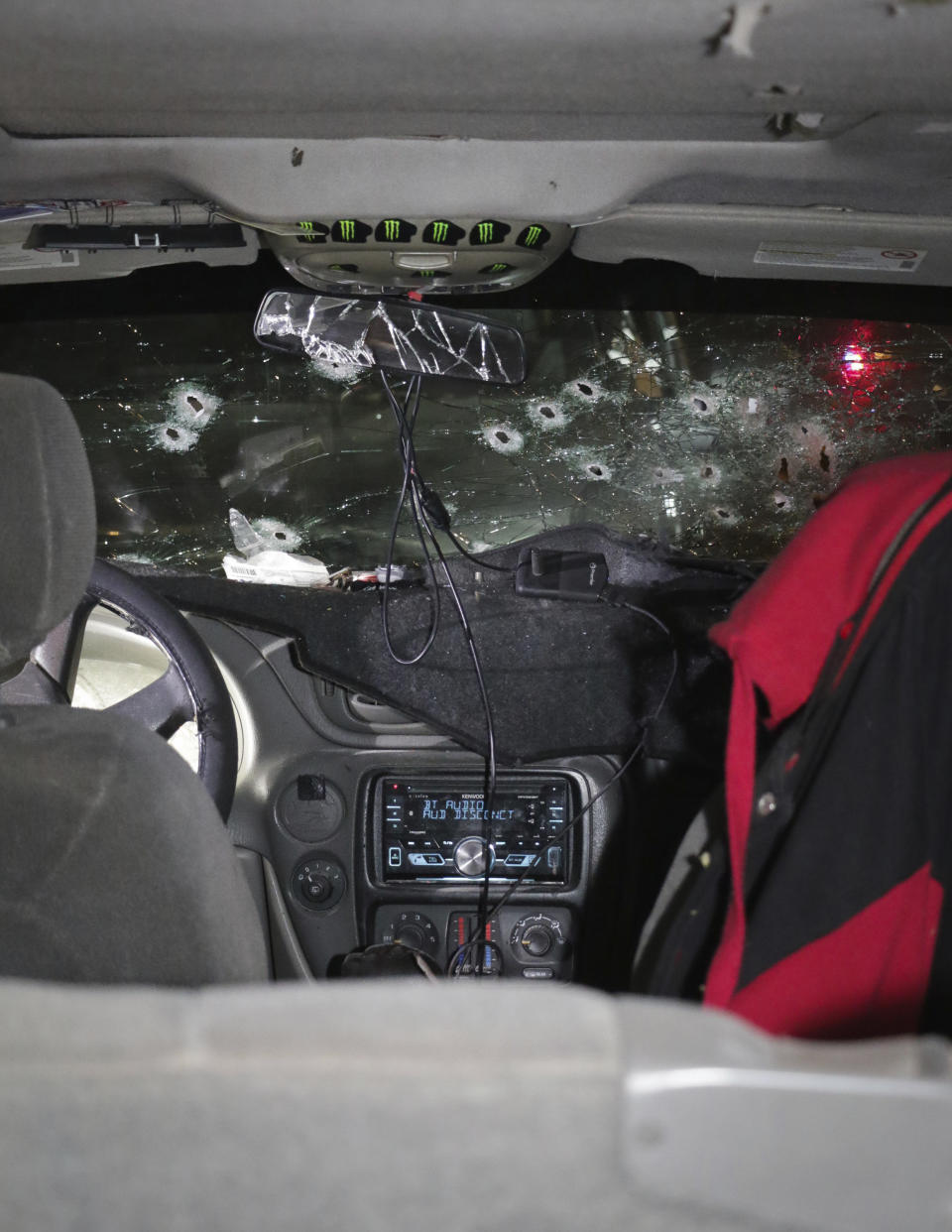Agents' shootings escape scrutiny, use-of-force reforms
PHOENIX (AP) — First came the crash, reverberating off the walls of the retirement community like a “mini atom bomb,” then a barrage of gunfire shattered the desert morning calm.
Neighbors working in their garages and gardens scrambled for cover, as rounds ripped through metal and cut into picnic tables. One woman hit the floor of her bedroom and called 911. Nearby schools and daycare centers worried if they should go on lockdown.
“It was a war zone,” said Frank Guy, who was in his yard in the Ahwatukee Foothills neighborhood when the shooting started. “I haven’t heard that much rapid fire in that short of a period of time since I was in Vietnam 50 years ago.”
Federal agents from Homeland Security Investigations (HSI), a division of U.S. Immigration and Customs Enforcement, were pursuing a suspected human smuggler they’d been tracking for days. In three unmarked pickups, four plainclothes members of HSI’s Special Response Team followed the suspect’s SUV as it exited Interstate 10 south of Phoenix, took an unexpected turn and headed into a neighborhood of neat stucco homes and walking trails.
As the convoy barreled through the community, the agents decided to conduct a high-risk maneuver intended to force the SUV to stop. Instead, within seconds, an HSI pickup lay atop a downed tree halfway through a garden block wall, the driver of the SUV was dead from multiple gunshots, and her four passengers, including the alleged smuggler and a teenage girl, were wounded or injured.
The April 11, 2019, shootout in Ahwatukee, although extreme, was not an isolated incident. Since 2011, there have been at least 13 shootings involving HSI agents – most of them in 2018-19, according to an investigation by the Howard Center for Investigative Journalism. Reporters found media reports on other HSI-involved shootings, but could not independently confirm the details and did not include them in the count. It’s not clear how many HSI shootings have occurred in the U.S. because ICE officials refused to answer questions and the agency’s data is not made publicly available.
——
This article was produced by the Howard Center for Investigative Journalism at Arizona State University’s Walter Cronkite School of Journalism and Mass Communication.
——
The Howard Center confirmed that at least five people had been killed and 11 others, including a 4-year-old boy, had been wounded or injured by HSI agent shootings, which often occurred in parking lots outside strip malls or restaurants. All but three of the victims were black, Hispanic or Native American. One suspect in California was shot in the back and killed, and an innocent man in the same state was mistakenly shot at after dropping off a child at school. Another man in Chicago, who was not a suspect, was wounded in his home, the Howard Center found.
Arizona had the most HSI agent-involved shootings, but at least eight other states had at least one since 2011, the year after ICE created HSI.
No agent has been charged in connection with any of the shootings. Four federal civil rights lawsuits have been filed. A confidential settlement was reached in the California case of mistaken identity. A lawsuit in Florida was dismissed by a federal judge who found the agents acted reasonably. Two federal lawsuits — related to shootings in Chula Vista, California, and Chicago — are pending.
Officials from ICE and HSI refused repeated requests from Howard Center reporters for interviews or to answer written questions. The agency has previously said its Office of Professional Responsibility reviews all agent-involved shootings; those investigations have not been made public.
Larry Cosme, the national president of the Federal Law Enforcement Officers Association, said agents involved in shootings should be investigated because it promotes transparency, but added: “Those reports don’t need to be disclosed to be transparent.”
“HSI agents are doing a great job and they’re doing the job under circumstances that are very difficult to deal with,” said Cosme, a retired HSI agent. "They are trying to protect the communities that we all live in.”
HSI is the main investigative unit of the Department of Homeland Security, the parent agency of ICE. Its more than 7,000 agents have broad legal authority to investigate an array of cross-border crimes, from child pornography and human smuggling to art theft and financial crimes. Yet its operations are largely overshadowed by the department’s border detention units and illegal immigration roundups.
The Department of Homeland Security’s Inspector General has released a half-dozen reports since 2016 highlighting deficiencies in management, training, oversight and use of force within the department and its component parts, including ICE and HSI. After President Donald Trump ordered the department to hire thousands of additional agents, the inspector general warned that training concerns would “likely become more serious,” especially with HSI, which “relies heavily on temporary duty instructors with abbreviated assignments.”
“This approach is not only expensive but also ineffective in terms of ensuring consistent, safe instruction,” the inspector-general said in a November 2018 report.
Howard Center reporters pieced together details of HSI agent-involved shootings using police reports and other official documents from state agencies, obtained through public information requests, as well as court records, lawsuits and interviews.
Common themes include HSI agents calling 911 for help after a shooting, refusing to answer questions at the scene, leaving without conducting walk-throughs with local police, and giving statements only days later with their lawyers present.
Federal use of force shooting incidents have escaped the kind of scrutiny faced by state and local law enforcement officers involved in shootings of unarmed black men, which gave rise to the Black Lives Matter movement and community policing reforms. Experts say that’s no accident: federal agencies have hoarded their shooting data, making it nearly impossible for independent analyses of their policies and practices.
“A lot of (local police) departments are transparent,” said Geoffrey Alpert, an internationally recognized criminal justice expert who has studied high-risk police activities for three decades. “The federal government chooses not to be.”
Experts also said it would be misleading to compare the number of federal law enforcement shootings with those by local officers because their missions differ and local police have more interaction with the public.
The Phoenix Police Department, in response to a Howard Center public records request, released its full investigative report on the Ahwatukee shooting, including 911 calls, body cam videos, agent and suspect interviews, and thousands of crime scene photos.
However, one piece of evidence that was released — recorded sounds of the shootout picked up by a nearby home security system — was not analyzed by police. A review of that recording, conducted for the Howard Center by two national ballistics experts, found that handguns like those used by HSI agents were the first to fire, contradicting the official narrative that the “bad guy” shot first.
Phoenix police officials would not publicly discuss their investigation, though privately some officers were critical of HSI’s tactics.
The prosecuting attorney for Maricopa County, which has jurisdiction for the Phoenix area, criticized agents in writing for refusing to follow officer-involved shooting protocols, saying that limited “the degree to which involved agents can be fully and confidently cleared of any wrongdoing.”
Police shooting experts raised similar concerns.
“It’s a major concern, the accountability of people who have the power to deprive us of life and liberty,” said George Kirkham, criminology professor-emeritus at Florida State University who’s consulted on more than 1,500 law enforcement cases throughout the U.S. “It’s an honorable profession, and the people who do it do a tough and important job. But they must be held to account.”
___
This article was provided to The Associated Press by the Howard Center for Investigative Journalism at Arizona State University’s Walter Cronkite School of Journalism and Mass Communication, an initiative of the Scripps Howard Foundation in honor of the late news industry executive and pioneer Roy W. Howard. Reporters Joel Farias Godinez, Maia Ordoñez and Alexandra Edelmann contributed to this report. For more information see http://azpbs.org/homelandsecrets.




